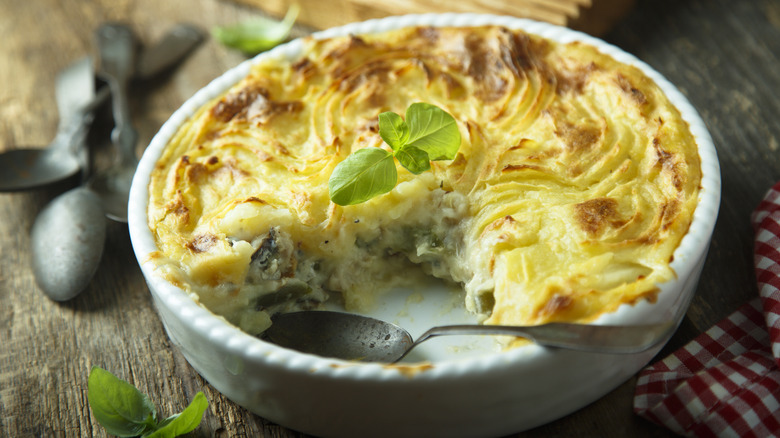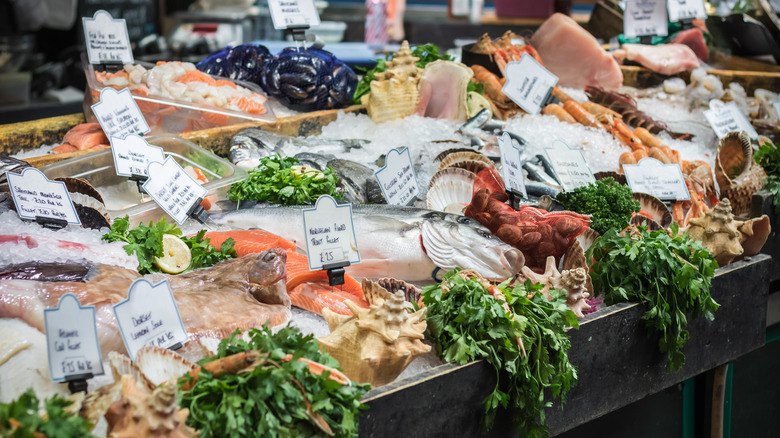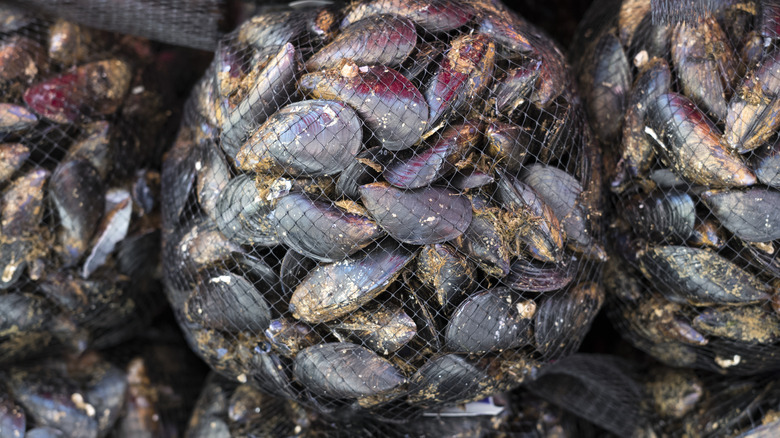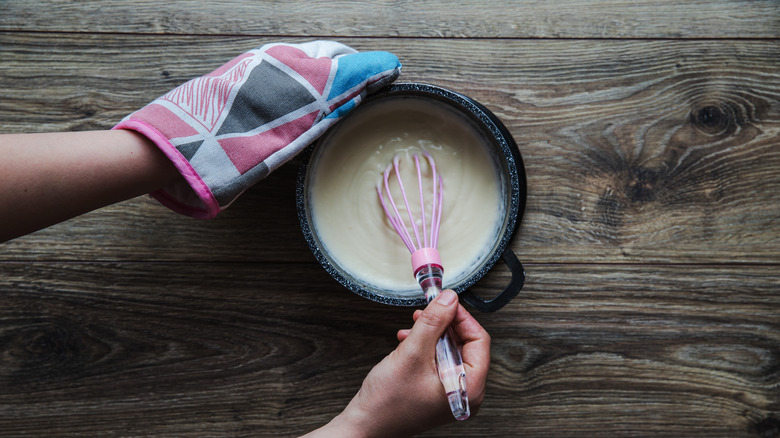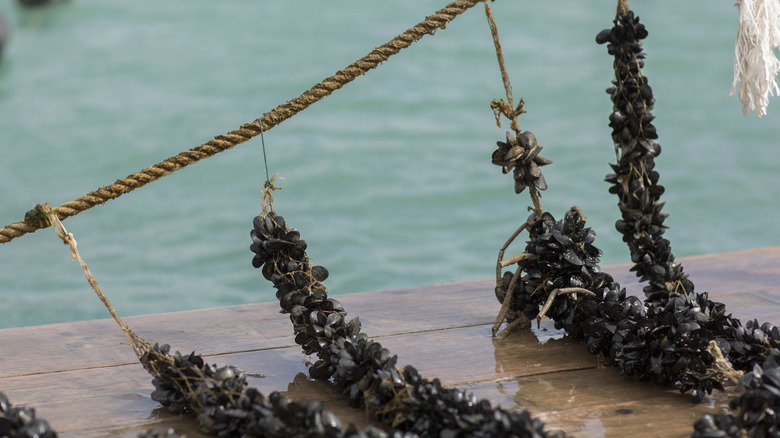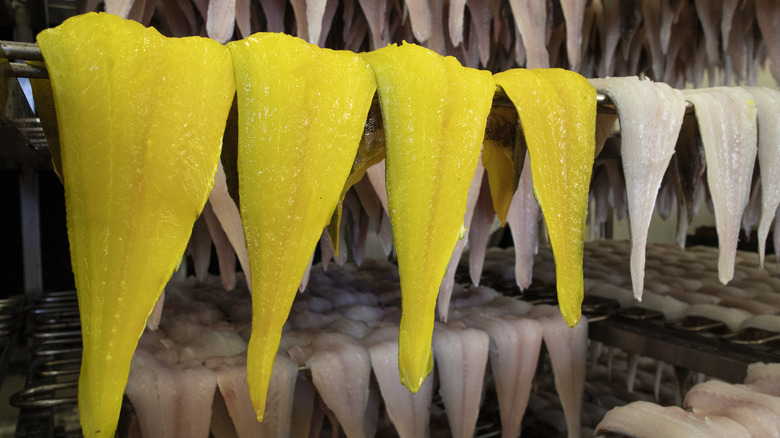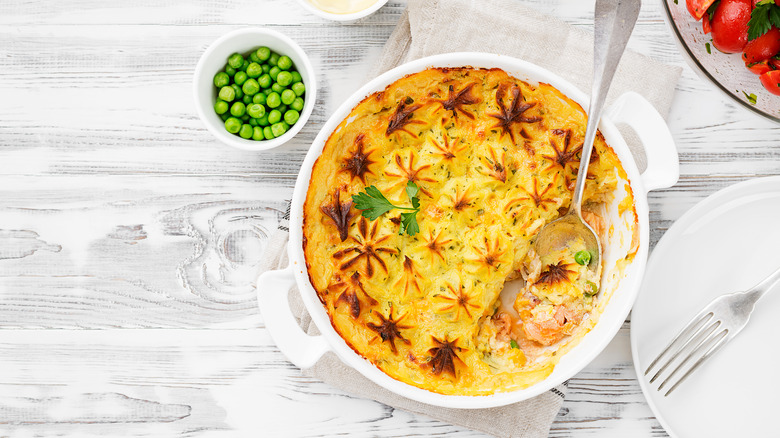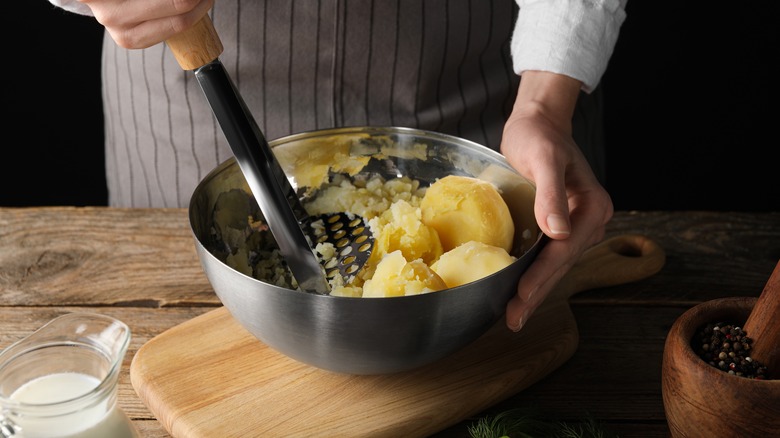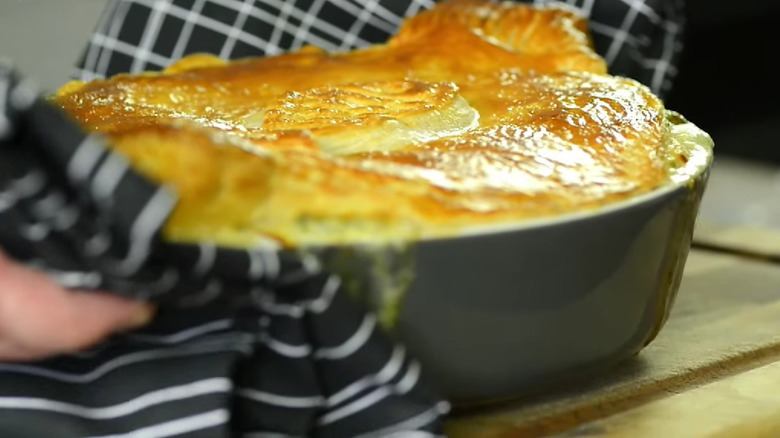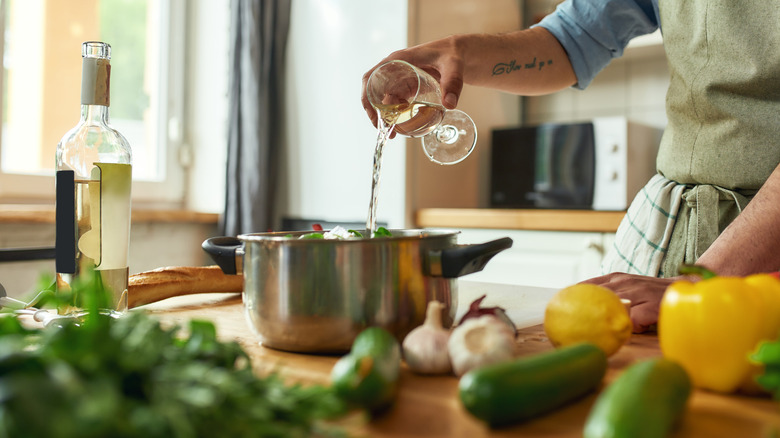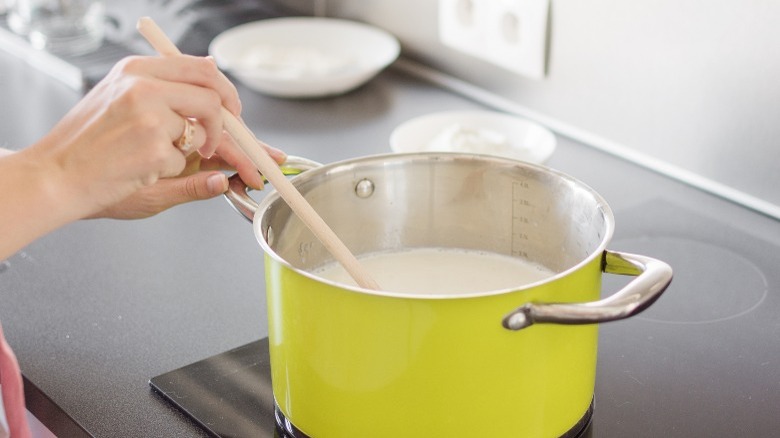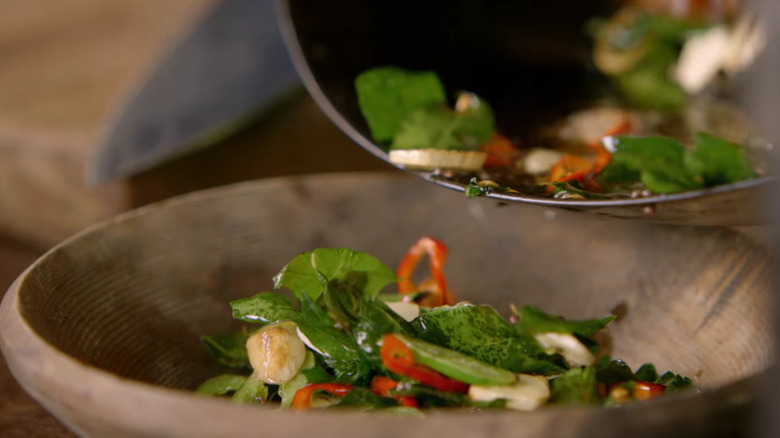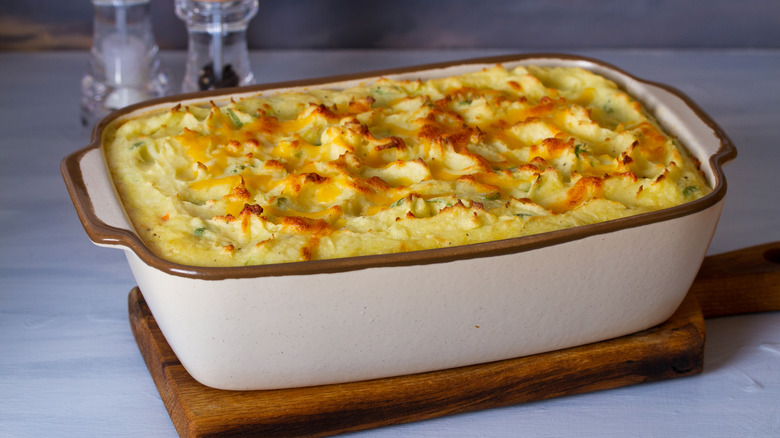12 Ways To Upgrade Homemade Fish Pie
Fish pie is a deeply comforting dish that has long warmed the hearts and souls of the British populace. Despite its traditional roots, fish pie — as comfort food — benefits from a degree of variability not afforded to more serious dishes. But this is one of its great strengths: fish pie can be altered to suit any season, geographic location, or preference.
This dish can take on many beautiful and unique forms. These range from mashed potato-topped pies to Stargazy pies, which feature protruding fish heads. As there are a myriad of ways to make a fish pie, there are also numerous ways to elevate the dish. The sourcing of high-quality ingredients and the adoption of different cooking techniques are some routes you can take.
When it comes to tweaking a dish, there are many food enthusiasts who become caught up in trying to achieve perfection. But we think the only meaningful criterion for measuring a fish pie's success is its ability to comfort those around the table. Cooks should focus on making the most heart-warming version of this British classic. Here are a few tips to help you along the way.
1. Buy fish from a fishmonger
As with all cooking, the quality of the ingredients dictates the quality of the final dish. Fish, as the star of the show, should always be sourced fresh and be of the highest possible quality. The best place for most people to find high-quality seafood is at their local fishmonger. No matter where you are in the world, fishmongers will have information on where and how their fish was caught. They will also stock a wide range of seafood varieties while being able to guarantee the product's freshness. This makes fishmongers far superior to many grocery stores.
Thankfully, fish pie's variability makes it extremely well-suited to fishmonger shopping. This was highlighted by cookbook author and chef Angela Clutton to SLMan: "The best fish pies don't start with a rigid set of ingredients, but with a conversation with the fishmonger about what is good, fresh and available. Aim for a mix of three or four fish."
Combining different types of fish gives the pie a well-rounded taste and varied texture. Mild and firm fish like haddock or cod should be supplemented with oily fish such as mackerel, salmon, or tuna. Finally, smoked fish will lend extra flavor to the dish. Tinned products, like anchovies, can even be used to add a punch of flavor.
2. Consider crustaceans and bivalves
While fish are the predominant ingredient in the dish, other types of seafood can also play an important role when making fish pie. The other products used are a matter of personal preference. For example, some experts recommend adding scallops and lobster, for a more luxurious feel. Others suggest that the delicate flavors of these expensive seafoods are lost during cooking.
Prawns are another popular addition to fish pie. Their meat adds flavor and a meaty texture to the filling. While many people will only buy these crustaceans for their meat, the animal's shells and heads are just as important. These can be fried or roasted before being used to infuse your fish pie's bechamel sauce with additional fish flavors.
Pies made using this method have an unrivaled depth and quality of flavor evident throughout the dish. Mussels can also be used to achieve similar results. Chef Laurie Gear explained the importance of a flavorful sauce to SLMan: "The key to any dish is a great sauce. When making fish pie at home, I always steam off a few mussels in Dorset cider and return the remaining cooking juices into a sauce made from flour, butter, fish or chicken stock, milk and double cream infused with a small onion studded with a couple of cloves and a bay leaf."
3. Infuse your bechamel sauce
As previously mentioned, numerous ingredients can be used to infuse bechamel sauce — a common ingredient in fish pie – ranging from prawns to mussels. But you can infuse your fish pie's bechamel sauce with more than just fishy flavors. You can also use things like onions and herbs.
Using vegetables and herbs is a surefire way of elevating the flavor of fish pie. But there is another means of infusing your bechamel that benefits both the sauce and the dish's main ingredient. We are referring to the popular practice of poaching fish in milk. The milk can subsequently be used to make the bechamel.
Using this method results in a succulent fish that is moist and flakes well — perfect for use in a fish pie. Many chefs, like Tom Booton, swear by poaching, as he highlighted to SLMan: "The key to making a delicious fish pie is to lightly poach the fish in milk at around 70°C, until it's almost cooked. Use that milk to make your bechamel sauce and throw in dill, chives and — most importantly — a generous amount of wholegrain mustard. It makes it super delicious."
4. Prioritize sustainable seafood
Fish pie's inherent variability makes it the perfect dish to swap out popular types of seafood and utilize sustainable options instead. Substituting salmon – a ubiquitous feature of many fish pies — is a brilliant place to start. Most salmon available to consumers is now farmed – a practice that is often not considered sustainable. Pollack, hake, and halibut are all suitable replacements for salmon.
Bivalves, such as mussels, are another flavorful and sustainable option for fish pie fillings. Bivalves can be easily farmed, with less of a negative impact on the environment. As filter feeders, bivalves even clean the water they live in. This makes farming them incredibly sustainable.
What's more, the inclusion of bivalves elevates the nutritional profile of fish pie. This was highlighted by zoologist David Willer to BBC: "Bivalves have the remarkable potential to provide people with food that is not only environmentally sustainable but also nutrient dense ... If just 25% of this 'carnivorous fish' aquaculture was replaced with an equivalent quantity of protein from bivalve aquaculture, 16.3 million tonnes of CO2 emissions could be saved annually – equivalent to half the annual emissions of New Zealand."
5. Use at least one type of smoked fish
We have mentioned that using a variety of different fishes is bound to make a great fish pie. But for the very best results, it's essential that one of these varieties is smoked. The inclusion of smoked fish elevates the entire dish, by lending the recipe a level of complexity through the addition of smoky flavor.
Smoked trout, mackerel, or even salmon can be used to fulfill this role. Chef Gizzi Erskine highlighted why she likes to use smoked fish in her fish pies when being interviewed by SLMan: "I prefer to use smoked fish in my pie because it adds real depth and body to the dish. I would normally use smoked haddock because it's British and firm, but sometimes I add salmon and cod."
Using smoked fish in a fish pie is a delicate balancing act. Too little and the flavor will not be pronounced, too much and it will be overpowering. Although opinions vary, having a one-third smoked fish to two-thirds non-smoked fish ratio is a good place to start.
6. Add vegetables for extra body
Seafood is the most important part of a fish pie filling, but that doesn't mean it's the only part. Vegetables are also vital when it comes to this iconic dish, as they add extra bulk and variance to the filling while introducing new flavors.
Alliums such as leeks or onions are a natural match for fish and perform well in fish pie. That being said, there are numerous other vegetables that are suited to incorporate into the dish, including spinach. Mashed root vegetables are even suggested as an alternative to the traditional mashed potato topping. Frozen peas and carrots are also suggested as possible additions.
However, we would warn against the incorporation of these last two vegetables, for the simple reason that they are often served as accompaniments to fish pie. In this manner, they provide a welcome respite from the heavy pie, with their freshness and bite.
7. Make your mash with starchy potatoes
When it comes to mash, not all potatoes are made equal. These tubers can be broadly split into two categories: starchy (also known as floury) and waxy. Most cooks seem to prefer starchy. These potatoes are high in starch, which allows them to be easily broken down. This is perfect for making a smooth, comforting mash.
Bob Andrews, the former head chef of the restaurant Riverford, highlighted his favorites to SLMan: "Don't load your mash with too much milk and butter – you're not making pomme purée. You want it to be firm enough to feel like a separate and distinct layer of topping that needs to be broken through to get to the luxurious filling beneath. Also, make sure you choose the right potato. You want a floury variety for the optimum fluffy mash – Sorrento, Maris Piper, Cosmos or King Edward."
Waxy potatoes, like Red Bliss, keep their shape when cooked, making a smooth mash difficult to achieve. Interestingly, some chefs like to use waxy potatoes, as the resulting mash is great at absorbing the flavors around it. While this may be the case, the textural challenges of this approach should prevent all but the most adept cooks from attempting it.
8. Consider different toppings
Fish pie's traditional topping is mashed potatoes. This has long been seen as the perfect vehicle for soaking up the dish's iconic sauce (usually a recipe known as white sauce). Mashed potatoes, however, are not the only option when it comes to toppings. Several cooks choose to eschew potatoes for puff pastry, giving the dish an enticing textural contrast. The downside of this approach is that the high-fat content of puff pastry can make this already rich dish even more heavy.
Other recipes use potatoes but in a novel way. Chef Rosie Sykes recommends using grated potato topping, according to The Guardian. This rosti-style topping transforms the dish through the introduction of new textures. Syke's approach also allows cooks to experiment with a variety of potato types, not just floury ones.
Another option for those looking to elevate their fish pie topping is to add additional ingredients to their mashed potato topping. Breadcrumbs and parmesan cheese are two of the most common means of transforming the standard pie topping into a crisp, golden, and flavorful alternative.
9. If using alcohol, make sure it is of good quality
Many cooks understand the importance of cooking with high-quality produce. Yet, these very same people do not apply this approach when cooking with alcohol. This is a grave mistake; as with any ingredient, using poor-quality alcohol will negatively impact the final dish.
Wine is the most frequently used alcohol when making fish pie, it often being incorporated into the sauce-making process. Chef Callum Graham highlighted this to SLMan: "When making the base of the fish pie, I'd always recommend making your own stock from the fish bones as it really enhances the flavour ... fry off some celery, garlic, fennel and shallots. Once soft, add 200ml of white wine along with the bones and top with 1.5 litres of water. Bring to the boil then simmer for 20 minutes until reduced by half."
When it comes to wine, the general advice is to only cook with the liquid you would be happy drinking. James Beard, the famed American chef, goes a step further, suggesting cooks not only cook with a wine they'd drink but one they would pair with the particular dish they are cooking. In fish pie's case, chardonnay, Chenin blanc, and muscadet work well. The added benefit of this approach is that you can enjoy the remainder of the bottle alongside your meal.
10. Make sure your bechamel is thicker than usual
Bechamel — a creamy sauce synonymous with fish pie — is the thing that brings the dish's components together. As such, it is of paramount importance that the bechamel is cooked correctly. We have touched upon how infusion benefits the bechamel's flavor, yet the consistency also requires attention. Chef Tom Aikens explained as much to SLMan: "Make sure you make the white sauce or bechamel thicker than normal, as you will always get some excess moisture coming out of the fish. I like to add finely chopped shallots to the base of the sauce as well as white wine, then use 50:50 fish stock and milk, finished with a little cream."
A watery fish pie is nobody's idea of a good meal. To prevent this from happening, cooks are advised to boil their bechamel for a slightly longer duration or to use a greater ratio of roux (a cooked mixture of fat and flour) to milk. Both will ensure the bechamel is thicker than usual.
As always when making a bechamel, constant stirring is required when the sauce is boiling. This ensures that the sauce adopts a uniform texture that is free from lumps. Stirring also prevents any part of the sauce from sticking to the bottom of the pan and subsequently burning. It's also important to note that the addition of other ingredients in the bechamel, like cheese, will also cause the sauce to thicken. Please take this into account before you start boiling the bechamel for extended time periods.
11. Don't be afraid of untraditional ingredients
While fish pie is a dish steeped in history, it is also extremely responsive to modern iterations and new inclusions. This allows cooks to experiment and produce a dish that, while familiar to the eyes, offers something completely new in terms of taste. You can do this by adding untraditional ingredients like saffron, chorizo, and tomato stock into your recipe.
Another twist on fish pie that is popular in the United Kingdom is curried fish pie. This variation is made through the simple inclusion of curry powder, curry paste, or by making a traditional tadka — an Indian cooking technique that helps to coax the flavor out of spices. For those that live in the U.K., the marriage of fish and curry flavors is a natural one. The ubiquity of curry sauce in the country's many fish and chip shops attests to this.
12. Let the pie rest before serving
As with all savory pies, fish pie greatly benefits from being rested prior to serving. The reasons behind this are twofold. Firstly, allowing the pie to rest means the bechamel cools slightly. This causes the sauce to thicken, limiting the chances of the fish pie being watery and resulting in the comforting texture the dish is known for.
Secondly, research suggests that humans' perception of taste drops when eating scalding hot food. In fact, any food served above 95 degrees Fahrenheit will have a less pronounced taste. Karel Talavera Pérez, a professor of molecular and cellular medicine, explained this to The Guardian: "Perhaps we do taste at such temperatures, but we don't pay attention to it because we become worried about the burning feeling." With its bubbling sauce and browned top, fish pie is notorious for being a piping hot dish. As such, your fish pie will taste better after being rested for 10 to 20 minutes. Don't fear, the dish will still be hot at this point, just not scalding.
